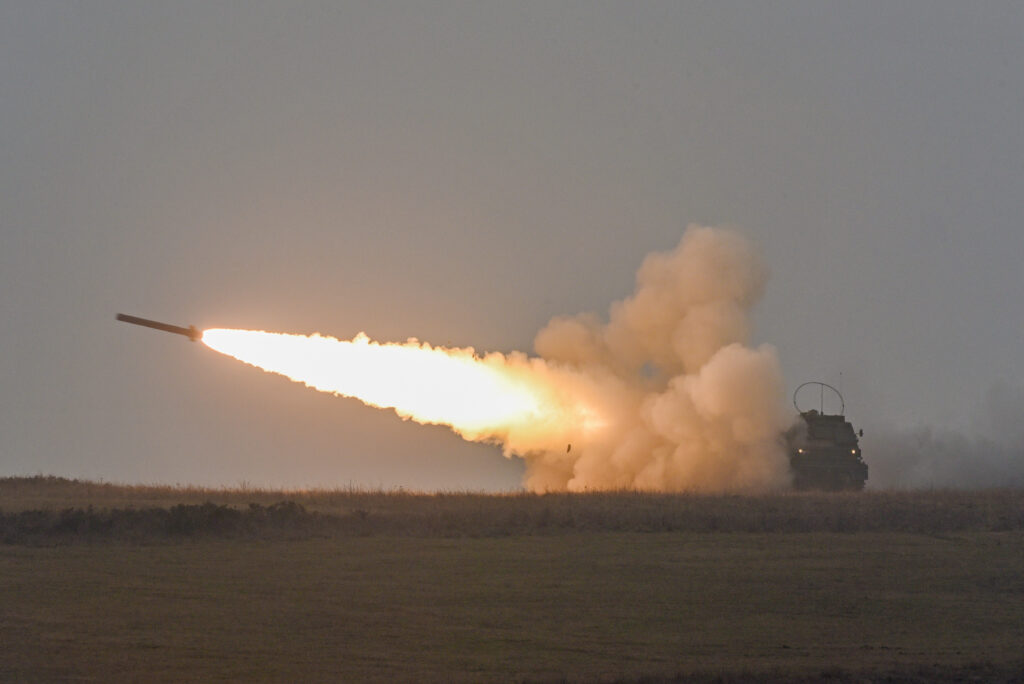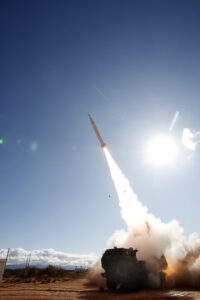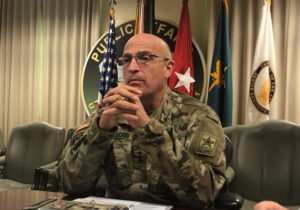
M270A1 Multiple Launch Rocket System (MLRS) firing at the Grafenwoehr training range in Germany.
UPDATED with Lt. Gen. Karbler remarks WASHINGTON: A successful field test in Germany shows how satellite surveillance, artificial intelligence, and long-range artillery could combine to devastating effect in future war, a senior Army official said this morning. The data from that test will feed into both computer models and future field experiments later this year in the US – part of the ambitious Project Convergence exercise – and in the Pacific.
“We have valuable data now on actually how the real operational system works,” said Willie Nelson, de facto head of space efforts at Army Futures Command. “To be able to provide that data back to the warfighter near real time …I know the word ‘game-changer’ is overused, but frankly, that is a game-changer.”

Willie Nelson addresses a Defense News webcast
“This is not just science experiments,” he told a Defense News webcast following on yesterday’s virtual Space & Missile Defense conference. “We actually used the fielded equipment” – M777 towed howitzers and M270 MLRS rocket/missile launchers – “with live fires on the range in Germany.” The upcoming tests will add Extended Range Cannon Artillery (ERCA) and Grey Eagle drones.
“Eventually we want this stuff on every ground platform and even down to the soldier,” he said, “but those are a couple of years away.” (While Nelson didn’t mention it, the new IVAS targeting goggles about to enter service will eventually link their wearers to AI target recognition system).
Connecting an ever-wider network of different sensors to “shooters” — with AI accelerating the data flow over land, sea, air, space, and cyberspace — is central to the Pentagon’s evolving concept of Joint All-Domain Operations.
In this year’s tests, “we’re doing that entire fires kill chain” from initial detection to final destruction, Nelson said. “We’re able to receive that [satellite] data in theater, process that data, be able to develop targeting coordinates from that, put it directly into the [artillery] firing system, AFATDS, and be able to launch weapons on target,” he said. “And we’re doing that now very successfully in a very short time.”
Nelson isn’t given to overstatement. In fact, he’s among the most reserved of Futures Command’s eight Cross Functional Team directors, and, not coincidentally, the only civilian among them. Nominally, his CFT handles Assured Precision, Navigation, & Timing (APNT) – in layman’s terms, alternatives for GPS if it’s jammed – but its mandate has expanded to include the Army’s use of satellites. Nelson’s team has been working closely with the Army’s Network CFT, ISR Task Force, and AI Task Force on this technology.

Lockheed’s prototype Precision Strike Missile (PrSM) fires from an Army HIMARS launcher truck in its first flight test, December 2019.
Satellites, AI & Humans
Today, artillery units rely on scout helicopters, drones, and forward observers on the ground to spot targets. But to counter Russian and Chinese long-range missiles, the Army is developing a family of long-range weapons – including hypersonics with a thousand-plus-mile range – that can hit targets much farther away than any earthbound asset can see, while recon aircraft are prime targets for ever-more-sophisticated surface-to-air weapons.
“You can’t assume air superiority, at least very early on, and so quite frankly the only avenue we have is to sense from space,” Nelson said. “The good news is, our access to space has greatly improved over the years, through a lot of innovation through commercial capabilities, primarily.”
A growing “variety of government and commercial satellites” in Low Earth Orbit, Nelson said, can provide data of multiple types. The Army has said it doesn’t need to build its own satellites for intelligence, surveillance, and reconnaissance.
UPDATE “With the standup of the space force, the Army should not be in the business of its own launch services [for] satellites,” Lt. Gen. Daniel Karbler, who heads Army Space & Missile Defense Command, told reporters this afternoon. “Army space starts and ends on the ground.”
While the Army has experimented with small satellites in the past, Karbler and his staff today made clear the service isn’t interested in building its own constellations. (That doesn’t rule out Army payloads hosted on satellites built and launched by others, however). “We identify the requirements that we need…and we hand those requirements on the space enterprise,” he said. “That could be DoD, that could be commercial, that could be other agencies.” UPDATE ENDS
Those rapidly expanding constellations of non-Army satellites provide a wide array of data, from straightforward photographic imagery, to triangulated sources of radio emissions, to Synthetic Aperture Radar. it’s SAR that Nelson is most excited about, not only because it can penetrate cloud cover and the dark of night, but because commercial R&D has improved the tech to where it can fit aboard a small LEO satellite.
Historically, each of these different data sources would go to a different human analyst. It would take multiple specialists in different fields to piece together – for example – how a blurry photo, an indecipherable radio transmission, and a ghostly radar image, each inconclusive on its own, could together pinpoint a potential target. Then a different set of specialists would take the list of targets and match it against the commander’s priorities and the available weapons.
In future conflicts, “we don’t have time for that,” Nelson said. That’s where the AI comes in. It can “radically reduce” the timeline by automating the grunt work, with software replacing human analysts and planners – but not, Nelson emphasized, human decision-makers.
“There need to be humans in the loop when we’re talking about lethal power,” he said.” “What we want to do is let machines do what machines do well[:] dull work, fast.”
Here’s Nelson’s outline of how this kill chain works, translated into layman’s terms:
- First, government and military satellites pass data to an Army ground terminal in-theater. The experiments so far have used surrogates for the future TITAN terminal.
- The first piece of AI software, called Prometheus, quickly combs the data for anomalies and correlations and then identifies potential threats and targets.
- The second piece of software, called SHOT, takes the list of hostile targets – either from Prometheus or another source – and compares them to the available friendly weapons. Based on ranges, locations, target characteristics, weapon performance, and a human-determined set of priorities, SHOT then computes the optimal match of weapons to targets, like Uber matching riders and drivers.
- SHOT’s recommended fire plan goes straight to the Army’s artillery fire control network, AFATDS, where the human commanders can choose to implement it or not.
- Satellites re-look the site to perform Battle Damage Assessment of whether the target was actually destroyed and feed that update back into the system, beginning the process again.
Who are the humans who must ensure this AI-accelerated cycle doesn’t spin out of control? The Army is figuring that out at the same time it field-tests the technology.
“It’s a strategic weapon,” said Lt. Gen. Neil Thurgood, who is developing the Army’s Long-Range Hypersonic Weapon. “It’s not long-range artillery.”

Lt. Gen. Neil Thurgood
The last time the Army had something comparable, it was nuclear-tipped: All the US military hypersonics now in development will be precision weapons with conventional warheads. So the Army can’t reprint old doctrine from the Cold War era, any more than it can use existing field artillery manuals for hypersonics.
The Army’s is exploring new kinds of organization, such as Theater Fires Command. Lt. Gen. Charles Flynn, the Army’s deputy chief of staff for operations, and Maj. Gen. Kenneth Kamper, head of the artillery school at Fort Sill, Okla., are leading an effort to develop new doctrine, Thurgood said. They’re collaborating closely with the all-service Strategic Command, which controls Air Force strategic bombers, ICBMs, and Navy nuclear missile submarines, and which will likely have a role in Army hypersonics too.
“Think of hypersonics as a strategic weapon,” Thurgood told yesterday’s SMD conference. “It literally is bringing the Army back into the days where we had weapons systems like Pershing, where we had strategic weapons that were part of the combatant command’s war plans, and those were held at the STRATCOM level.”
“The mission planning for the hypersonic weapon is at that level,” he said. “It is not happening at the battery level.”
“It is not a traditional field artillery mission,” Thurgood said at this morning’s follow-up webinar. “This is a detailed, preplanned set of events… that will happen at the STRATCOM level all the way down to the battery level.”
Sullivan says Ukraine supplemental should cover all of 2024, long-range ATACMS now in Ukraine
“We now have a significant number of ATACMS coming off their production line and entering US stocks,” Jake Sullivan said today. “And as a result, we can move forward with providing the ATACMS while also sustaining the readiness of the US armed forces.”


























